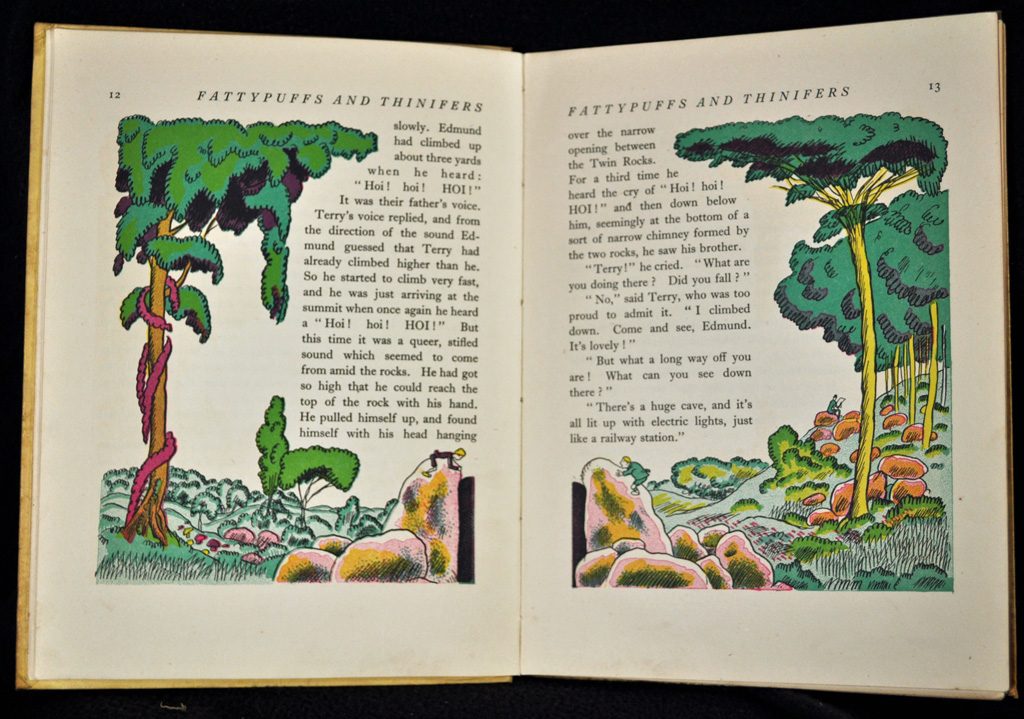Although I understand that a copy of the first English edition of this book is now rare and somewhat valuable, even without a dust wrapper, the book in my hands at the moment is, quite simply, one of my absolute favourites from a very early point in my life.
On the flyleaf there is written “Nicolas, from Ruth, Christmas 1942”. That would make me five years old. Great-aunt Ruth had never enjoyed children of her own but was really expert in seeking out the very newest and best books to give her many young relatives for birthdays and Christmas. She was really good fun, too – which I think is implied by her use only of her first name when corresponding with a boy of about 70 years her junior. Very sadly she did not survive many years into my life and the flow of wonderful books, at least from that source, dried up all too soon.
I have taken these photographs and write this now because I discovered the book (of course while looking for something else!) a few days ago. I immediately sat down and turned over the pages one by one in a rapture of nostalgic recognition. The text I knew well but it was the images that really worked on my memory. I knew them like the proverbial back of my hand and I automatically recalled staring at the detail of each – especially the ones were two equivalent drawings are seen side-by-side. Simple drawing style and strong letterpress colours left a wonderfully powerful impression.
There have been many reprints and different editions and even (anathema from my point of view) new sets of illustrations but there may still be some of you who have not come upon the book before, so I had better explain. I realise, incidentally, that the whole notion of the book would probably be greeted with horror by the health and safety (and discrimination) brigade – almost as much as some of the other favourite books of my childhood which I do not even dare to name!
The concept is simple. A fat boy and a thin boy, brothers, go into the countryside one day and find a gap between two rocks which they climb into and find a moving staircase that takes them deep into the earth. The fat boy finds himself in a country where everyone and everything is fat while the thin boy does the opposite. All sorts of exciting things happen, good and bad, but in the end a delightful reconciliation is brought about between the two countries and the boys return to the surface, in time for tea!
While not exactly plump, I was a sturdy child and had no difficulty in identifying with all the pleasures and comforts enjoyed by the Fattipuffs but the fact is that I cannot imagine anyone, however gaunt and disciplined and filled with all the other Thinifer virtues, who would actually prefer, for example, the Thinifer bed where an alarm clock immediately projects you into a cold bath to the warm and cosy fourposter in which the Fattipuff will luxuriate – with taps in each of the four posts from which drinks of different sorts can be extracted! Bliss, I always thought!
I hope you find you have copy lying around somewhere so read it and enjoy it – but I hope it is a copy with the Bruller illustrations!









Your love for Fattypuffs & Thinifers was passed down to us, albeit using a slightly more childproof Young Puffin edition from 1972. The illustrations from the paperback, though engaging, are not a patch on “your” copy.
Seeing the images above brings the memories flooding back and reminds me that there must have been occasions you risked the sticky fingers and let us have a read.
Thank you for that.
What a great book! I shall try immediately to acquire one, and pass it on to our elder grandson, Barney.
I suddenly remembered this book today having just celebrated my 85birthday I loved it and remember my edition had a yellow cover seeing the illustrations the years fell away. Has anybody heard of “ Puffin Twink andWaggle “ delightful stories for wartime bedtime reading, my father liked them as much as I did sheer escapism.
When my elderly friend commented on some neighbours of ours, many years ago, as ‘fattypuffs and thinifers, I thought he’d just made it up. I am delighted that it was inspired by a book he was probably given when he was growing up.
I have a copy of the 1968 edition with illustrations by Fritz Wegner. I bought in a library sale. One of my most favourite stories from my childhood and ANYTHING illustrated by Fritz Wegner is a winner for me!
My mother recalled her own mother calling her and her sister (respectively) a Thinifer and a Fattypuff, but hadn’t read the book herself. She was delighted to find a copy recently in a used-book shop and we have both read it with great pleasure. Illustrations are as above, but alas mostly just line drawings without colour.